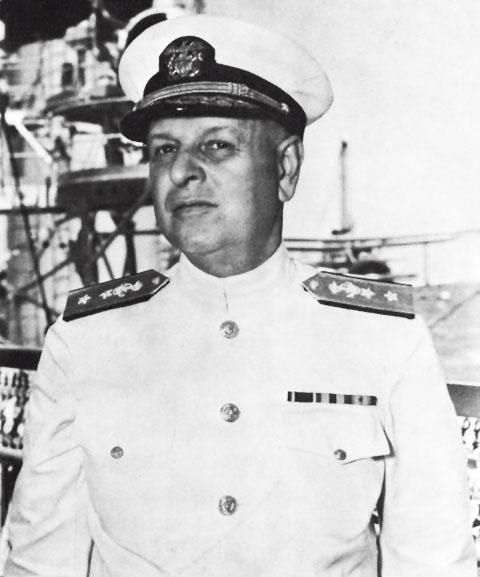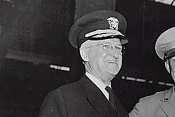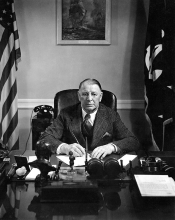Pearl Harbor Before December 7, 1941
United States
As stated above, the United States viewed Japan in a very paternalistic manner, in much the same way they viewed the Native Americans in the mid to late 1800s whom they also saw as inferior. Paternalism, in this case, can be defined by the following statement: the Japanese are under developed, but could and should be given the values and belief system of Western culture, and thus live in the most technologically advanced and civilized society possible. This view of the Japanese as inferior started in the 1800s and by the Washington naval treaty of 1922, Japan was expected to play an inferior role in relation to the United States in the Pacific Ocean. The United States expected the Japanese, under their guidance, to meet their need for food and raw materials through trade and mutual cooperation; not through aggressive expansion.
Negotiations
As a result of the Japanese invasion of Indo-China in 1940 and their continued presence in China, President Roosevelt, on July 26, 1941 , froze all Japan 's assets in America , and stopped selling Japan oil and other raw materials. In April 1941 both sides were talking, but by July the United States knew, as a result of the remarkable code-breaking operation known as Magic, the Japanese had made a decision at the Imperial conference on July 24, 1941 to combine diplomacy with a covert military offensive.
In Washington on November 26, 1941 Secretary of State Cordell Hull handed the Japanese Ambassador a note that laid out four principles that both the United States and Japan should and would follow in their relations with each other and other countries:
- The principle of inviolability of territorial integrity and sovereignty of each and all nations.
- The principle of non-interference in the internal affairs of other countries.
- The principle of equality, including equality of commercial opportunity and treatment.
- The principle of reliance upon international cooperation and conciliation for the prevention and pacific settlement of controversies and for improvement of international conditions by peaceful methods and processes. 8
These principles did nothing more than restate the United States' paternalistic position that Japan should maintain its inferior role in the Pacific. The note also stated The Government of Japan
will withdraw all military, naval, air and police forces from China and from
Indo-China.
9 This was the same demand that Roosevelt had made on July 24, 1941 . The note continued, The Government of the United States and the Government of Japan
will, respectively, remove the freezing restrictions on Japanese funds in
the United States and on American funds in Japan .
10Thus, as long as the Japanese behaved themselves their assets would be free and trade with the United States would be possible. It was clear
that Japan would not change its position.
United States Readiness for War
The United States in November 1941 was still coming out of the Great Depression and preparing for war. These preparations, wide ranging and slow, started in June 1940 when President Roosevelt appointed two Republicans to defense posts in the cabinet: Henry L. Stimson, Secretary of War and Frank Knox, Secretary of the Navy. The purpose of these appointments was to reinforce national unity. In July a bill signed by President Roosevelt authorized a two-ocean navy. By August 1940, units of the National Guard were induced into federal service, but that was not enough manpower. So, Congress adopted the first peacetime conscription (or draft) in American history. It called for the registration of all men age 21-35 for one year's military service within the United States. 11
America was and is a republic, and in such a system the government can do nothing without debate and that takes time. Thus, the above measures did not just walk through Congress. The House and the Senate had to listen to the American people who were, at the time, divided into two major camps internationalists and isolationists. The internationalists held the best way to defend the United States was to aid Britain and her allies. On the other hand, the isolationists held that Roosevelt was drawing the United States in to a needless war. That war would be in Europe the public did not look East toward Japan.
While the American public may not have been looking to the East the military was, and they put what they saw into war plans. The Joint Army and Navy Basic War Plan-Rainbow No. 5 stated which enemy, in case of war, would be dealt with first:
Since Germany is the predominant member of the Axis Powers the Atlantic and European area is considered to be the decisive theatre. The principal United States Military effort will be exerted in that theatre and operations of United States forces in other theatres will be conducted in such a manner as to facilitate that effort. 12
This Germany first plan put Japan on the back burner and thus the needs of the Army and Navy in the Pacific. The commanders at Pearl Harbor Admiral Husband E. Kimmel and General Walter C. Short had to make do with about 10% of the overall allotment of men and material. The other 90% were earmarked for Europe .
The 10% the commanders had were to say the least inadequate to the task. As Admiral Kimmel states in his book
Admiral Kimmel’s Story, He, [General Short] like myself, was
handicapped by personnel and material shortages and the influx of large
numbers of untrained officers and enlisted men.
13 The War Department allocated the Army in Hawaii 180 flying fortresses, but only 12 were in Hawaii before December 7, 1941 , and only six of
them could fly.14 The fleet had its problems with planes too according to Kimmel:
The Navy Department allocated about 100 patrol planes to the commandant of the 14th Naval District. He never received a single patrol plane. As a consequence, the base defense against air attack was predicated on borrowing fleet patrol planes for distant searches. Under the war plans these fleet patrol planes were earmarked for operations with the fleet thousands of miles from Hawaii should war come. Their primary mission was always connected to fleet operations. They were frequently based on the outlying islands-Midway, Wake, Johnston , and Palmyra.They had to train with the fleet and search areas in which the fleet operated. Under these circumstances, they were available for distant search from Oahu only when and if the fleet did not need them for its own operations, actual or impending. They were not at any time sufficient in number to cover in distance more than one-fourth of the area through which a force could approach Pearl Harbor. And this coverage maintained for a few days only. Search was to be instituted only when there was information from other sources that a carrier strike against the islands was possible within narrow time limits. This was a makeshift none better was possible with the means at hand. 15

The Army and Navy did not have enough planes on hand to carry out search operations according to war plans, which made their need for trained radar operators greater. They also were in short supply. Admiral Kimmel took Army personnel to sea with the fleet so they could be trained as radar operators. He also assigned a naval officer to the Army who had experience in Britain with radar to give any advice and assistance he could in connection with the aircraft warning net in Hawaii.16Sometime shortly there after Army radar was manned and operational. According to Admiral Kimmel:
General Short informed me his radar was operating and could give 100-mile coverage. In joint Army-Navy drills it did perform satisfactorily. In the period before December 7, I was informed that the Army's radar was manned.... 17
Communication Between Washington and Hawaii

Admiral Harold R. Stark

The Chief of Naval Operations (CNO) in Washington Admiral Stark, the next step above Kimmel in the chain of command, knew of the shortages of trained men and material in Hawaii. He in turn would have informed Henry Knox Secretary of the Navy (SECNAV). As SECNAV, Knox would have reported to the President; in like manner, intelligence in the form of Magic would have been sent to Admiral Kimmel Commander In Chief, Pacific Fleet (CINC PAC). At least, that was the way it should have worked. But, communication from Hawaii to Washington happened more often and was more useful than communication from Washington to Hawaii. As Admiral Kimmel stated:
The deficiencies of Pearl Harbor as a fleet base were well known in the Navy Department. In an interview with Mr. Roosevelt in June 1941, in Washington, I outlined the weaknesses and concluded with the remark that the only answer was to have the fleet at sea if the Japs ever attacked. 18
Admiral Kimmel CINC PAC voiced his concerns to the President himself, but the Germany first plan won the day, as it should. History has shown that to have been the best course of action.
Before the June 1941 meeting with Roosevelt Kimmel wrote an official letter to CNO Stark:
On 25 May 1941, I wrote an official letter to the Chief of Naval Operations [describing] my need for information of all important developments affecting our foreign relations…. I handed it to the CNO personally, and received his assurance that I would be informed of all important developments as they occurred, and by the quickest secure means available. 19
CNO Stark told Admiral Kimmel that he would be kept informed by the quickest secure means available. That statement meant as fast as the bureaucratic system used for code breaking could work. That system, at best, worked at a speed of dead slow.
The commanders in Hawaii were never supplied with the equipment or personnel to decode Japanese intercepted diplomatic messages. These Magic intercepts, then had to be decoded in Washington at the Office of Naval Intelligence (ONI) and sent to Hawaii . The Asiatic Fleet, however, had such equipment and personnel. There were gaps in the information sent to Kimmel. The message of September 24, 1941, for example, a message which Kimmel should have received some time before the attack such that Hawaii crystallized as a point of attack for the Japanese was never sent to him. The message read:
Strictly secret.
Henceforth, we would like to have you make reports concerning vessels along the following lines insofar as possible:
1. The waters (of Pearl Harbor ) are to be divided roughly into five sub-areas (We have no objections to your abbreviating as much as you like.)
Area A. Waters between Ford Island and the Arsenal.
Area B. Waters adjacent to the Island south and west of Ford Island . (This area is on the opposite side of the Island from Area A.)
Area C. East Loch.
Area D. Middle Loch.
Area E. West Loch and the communication water routes.
2. With regard to warships and aircraft carriers, we would like to have you report on those at anchor (these are not so important) tied up at wharves, buoys and in docks. (Designate types and classes briefly. If possible we would like to have you make mention of the fact when there are two or more vessels along side the same wharf.20
The fact that Admiral Kimmel was never informed of the above message after CNO Admiral Stark told Kimmel that he would be kept informed is, to say the least, odd. The Director of Naval Intelligence Captain Allan G. Kirk thought the message should be sent
to Kimmel, according to Edward L. Beach Captain USN (Ret.) in his book
Scapegoats: A Defense of Kimmel and Short at Pearl
Harbor: the above message was read by the ONI in early October 1941.
…It was evaluated by some intelligence officers as the precursor of a
possible air attack on the area of interest. …Kirk saw it as such and urged
that it be sent to Kimmel.
21 But, Rear Admiral Richmond Kelly Turner, director of Navy war plans, objected; Kimmel was never informed. Why? 22
Communication between Washington and Hawaii clearly had gaps, and taken with the shortages of trained men and material in Hawaii added to the lack of readiness of the United States to respond to the attack. If Kimmel had been informed as he should have been it may have taken the Pacific Fleet less time to recover from the attack. That is all that can be said based on facts. There is no evidence that information known or thought to be critical, at that time, to commanders in Hawaii was withheld by design. It is more likely the bureaucratic system that was and is Washington caused the gaps in information. In such a system the information Admiral Kimmel did get did not point to Hawaii . The war warning message of November 27, 1941 read as follows:
This dispatch is to be considered a war warning. Negotiations with Japan looking toward stabilization of conditions in the pacific *have ceased* and an aggressive move by Japan is expected within the next few days. The number and equipment of Japanese troops and the organization of naval task forces indicates an amphibious expedition against either the Philippines Thai or Kra peninsula or possibly Borneo. Execute an appropriate defensive deployment preparatory to carrying out the tasks assigned in WPL46. Inform district and army authorities. A similar warning is being sent by War Department. Spenavo inform British. Continental districts Guam Samoa directed take appropriate measures against sabotage.23
The above message instructed Kimmel to carry out tasks assigned in war plans and watch for sabotage.
Notes
8 “United States Note to Japan November 26, 1941,” Department of State Bulletin, 5.129, December. 13, 1941, accessed July 26, 2015, http://avalon.law.yale.edu/wwii/p1.asp. (Hereinafter United States Note to Japan).
9 United States Note to Japan November 26, 1941
10 United States Note to Japan November 26, 1941
11 George Brown Tindall and David E. Shi, America: A Narrative History. Fourth Edition, (New York: W. W. Norton & Company, 1996), 1223. (Hereinafter Tindall).
12 Joint Army and Navy Basic War Plan Rainbow No. 5 Appendix I, accessed July 26, 2015, http://www.ibiblio.org/pha/pha/misc/rainbow5.html; Pearl Harbor Attack, Hearings Before the Joint Congressional Committee on the Investigation of the Pearl Harbor Attack, 79th Congress, First Session, 1946, Part 18: 2910. (Hereinafter PHA).
13 Husband E. Kimmel, Admiral Kimmel’s Story, (Chicago: Henry Regnery Company, 1955), 8.
14 Kimmel, 14.
15 Kimmel, 15.
16 Kimmel, 9.
17 Kimmel, 9.
18 Kimmel, 79.
19 Kimmel, 80-81.
20 Report of the Joint Congressional Committee on the Investigation of the Pearl Harbor Attack. July 16, 1946, accessed July 26, 2015 http://www.ibiblio.org/pha/pha/congress/part_4.html#181 (Hereinafter JCC Report); PHA, Part 12: 261.
21 Edward L. Beach, Scapegoats: A Defense of Kimmel and Short at Pearl Harbor, (Annapolis, Naval Institute Press, 1995), 34.
22 For a fuller examination of this question, see John Keegan, “For the Good of the Service: Husband E. Kimmel and the Aftermath of Pearl Harbor” (master’s thesis, Millersville University, 2010), 29-33, http://bit.ly/KeeganThesis02, (Hereinafter Keegan Thesis).
23 JCC Report; PHA, Part 14: 1406.